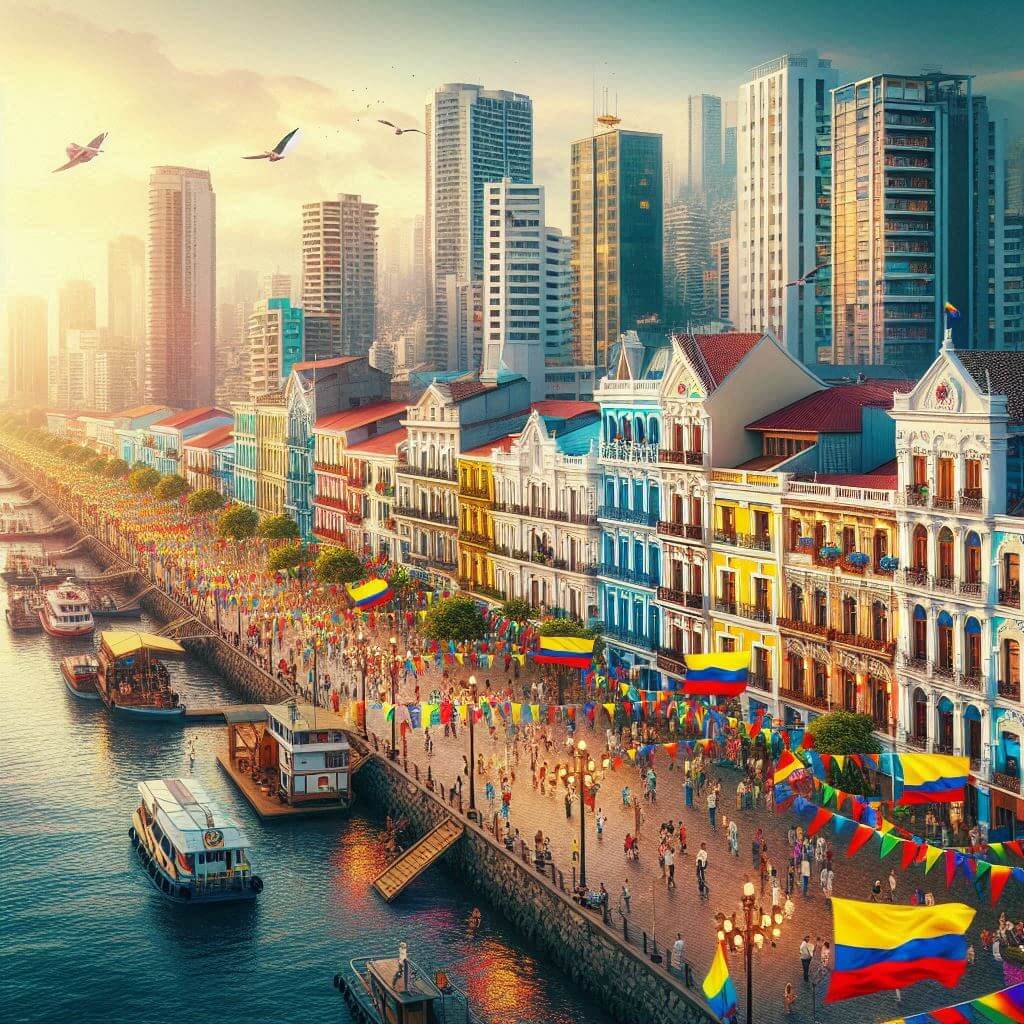The flag of Ecuador consists of three horizontal stripes: yellow (double width) at the top, blue in the middle, and red at the bottom. Centered in the yellow stripe is the national coat of arms. This vibrant design encapsulates Ecuador's geographical diversity, natural resources, and rich history.
Ecuador information
| National Flag Day | September 26 |
| Sovereign state | Yes |
| Official name | Republic of Ecuador |
| Capital | Quito |
| Population | 18,365,000 |
| Area | 283,561 km² |
| Currency | United States dollar (USD) |
| Language | Spanish, Kichwa |
| Continent | South America |
| Region | South America |
| Subregion | Andean states |
| Borders | Colombia, Peru |
| Timezone | Ecuador Time (ECT) UTC-5 |
| Calling code | +593 |
| Top-level domain | .ec |
History of the Ecuadorian Flag
 The current flag of Ecuador was officially adopted on September 26, 1860, during the presidency of Gabriel García Moreno. However, its history traces back to the early 19th century:
The current flag of Ecuador was officially adopted on September 26, 1860, during the presidency of Gabriel García Moreno. However, its history traces back to the early 19th century:
- 1820: The first version of the tricolor was used in Guayaquil during its independence movement.
- 1822-1830: Ecuador was part of Gran Colombia and used its flag.
- 1830: Upon gaining independence, Ecuador adopted a variation of the tricolor.
- 1845: The coat of arms was added to the flag.
- 1860: The current design was officially established, with minor modifications to the coat of arms over the years.
Symbolism and Design of the Ecuadorian Flag
Each element of Ecuador's flag carries deep symbolic meaning:
- Yellow stripe: Represents Ecuador's abundant agricultural resources, including its famous bananas and gold deposits. It also symbolizes the sun, a crucial element in Andean cosmology.
- Blue stripe: Signifies the Pacific Ocean and the clear skies above Ecuador. It also represents the ideals of peace and prosperity.
- Red stripe: Symbolizes the blood shed by heroes during Ecuador's struggle for independence from Spain.
- Coat of arms: A complex symbol featuring an Andean condor (representing power and freedom), a sun (Inca heritage), Mount Chimborazo, the Guayas River, a steamship (progress), and the zodiac signs for Aries, Taurus, Gemini, and Cancer (months of the independence movement).
Usage and Significance of the Ecuadorian Flag
 The flag of Ecuador is a powerful symbol of national identity and pride. It is prominently displayed on government buildings, schools, and during national celebrations such as Independence Day on August 10. The flag plays a crucial role in state ceremonies and is often waved enthusiastically by Ecuadorian citizens during international events and sports competitions.
The flag of Ecuador is a powerful symbol of national identity and pride. It is prominently displayed on government buildings, schools, and during national celebrations such as Independence Day on August 10. The flag plays a crucial role in state ceremonies and is often waved enthusiastically by Ecuadorian citizens during international events and sports competitions.
In everyday life, the flag serves as a reminder of Ecuador's rich biodiversity, cultural heritage, and the struggles for independence. It's common to see the flag displayed in homes, businesses, and incorporated into various forms of cultural expression across the country.
Interesting Facts About the Ecuadorian Flag
- Ecuador's flag is nearly identical to the flags of Colombia and Venezuela, reflecting their shared history as part of Gran Colombia.
- The flag is one of the few national flags to feature a coat of arms with a ship, representing Ecuador's maritime history and aspirations.
- September 26 is celebrated as National Flag Day in Ecuador, commemorating the flag's official adoption in 1860.
- The Andean condor on the coat of arms is also Ecuador's national bird, emphasizing its importance in the country's symbolism.
- The coat of arms on the flag is one of the most complex designs featured on any national flag, rich in historical and cultural references.